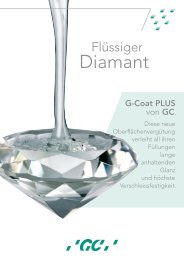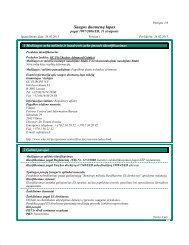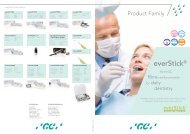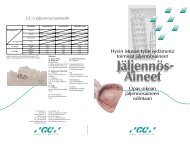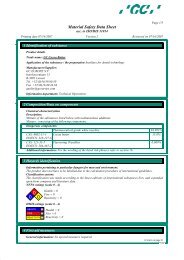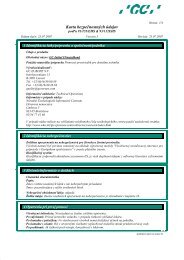Create successful ePaper yourself
Turn your PDF publications into a flip-book with our unique Google optimized e-Paper software.
3. <strong>GC</strong> <strong>GRADIA</strong> CHARACTERISTICS<br />
1. NATURAL AESTHETICS<br />
1) <strong>GC</strong> <strong>GRADIA</strong> colour tones and translucency similar to those of natural teeth<br />
Its level of brightness and light transmission is similar or closer to porcelain than conventional<br />
composites. Where required, the underlying tooth preparation can be masked while maintaining<br />
a natural, life-like appearing anterior jacket crown. Thus the <strong>GC</strong> <strong>GRADIA</strong>’s build-up technique<br />
mirrows those used for ceramics.<br />
2) Reduction of pale opalescence typical for composites<br />
The opalescence and fluorescence features typical for composites could not be avoided so<br />
far, especially with translucent colours. When a crown was seated under the light conditions<br />
found in the mouth, the excessively opalescent colour would make it impossible to reproduce<br />
the natural colour. These features have been changed in <strong>GC</strong> <strong>GRADIA</strong> by optimizing the filler<br />
particle size, thereby controlling and adjusting the diffusion of light through the material. This<br />
allows to maintain the desired colour, created at dentin level, also when the restoration is seated<br />
in the mouth.<br />
Comparison of translucency<br />
0.5mm<br />
1.0mm<br />
1.5mm<br />
Product A<br />
Dentin<br />
<strong>GC</strong> <strong>GRADIA</strong><br />
Dentin A<br />
<strong>GC</strong> <strong>GRADIA</strong><br />
Opaque Dentin A<br />
11: Jacket crown made with conventional composite<br />
21: <strong>GC</strong> <strong>GRADIA</strong> Jacket crown<br />
3) <strong>GC</strong> <strong>GRADIA</strong>’s complete spectrum of colours<br />
<strong>GC</strong> <strong>GRADIA</strong> has a complete spectrum of colours comparable to natural dentition offering wider<br />
range than other composite systems.<br />
Comparison of opalescence<br />
Comparison of fluorescence<br />
1. OPAQUS DENTIN (OD) is used to express the deep cervical colours. SHOULDER DENTIN (SD)<br />
follows the same concept as shoulder ceramic bodies.<br />
2. MAMELON STAIN (MS) allows to easily reproduce the dentin structure in the mamelon area.<br />
INTENSIVE COLOR (IC) is available in 15 shades and is effective in characterizing crowns with<br />
cracks, decalcification areas, etc.<br />
3. ENAMEL INTENSIVE (EI) shades create the appearance of depth. CERVICAL TRANSLUCENT<br />
(CT) has a translucent amber color that is particularly suitable for the cervical area.<br />
4. HALO ENAMEL (HE) is used to clearly express the contour of the tooth. PEARL ENAMEL (PE)<br />
is applied to express white lines/zones and cusp tips.<br />
<strong>GC</strong> <strong>GRADIA</strong> Product A Product B Product C <strong>GC</strong> <strong>GRADIA</strong> Product A Product B Product C<br />
A comparison of <strong>GC</strong> <strong>GRADIA</strong>’s translucent colour tones with its competitors demonstrates that colours and translucency are<br />
similar. However, a comparison of fluorescence on a black background – as in the mouth – shows that <strong>GC</strong> <strong>GRADIA</strong> features a<br />
more natural fluorescence compared with other products.<br />
<strong>GC</strong> <strong>GRADIA</strong>’s wide range of colours enables restorations to appear more like porcelain than<br />
other composites.<br />
5



